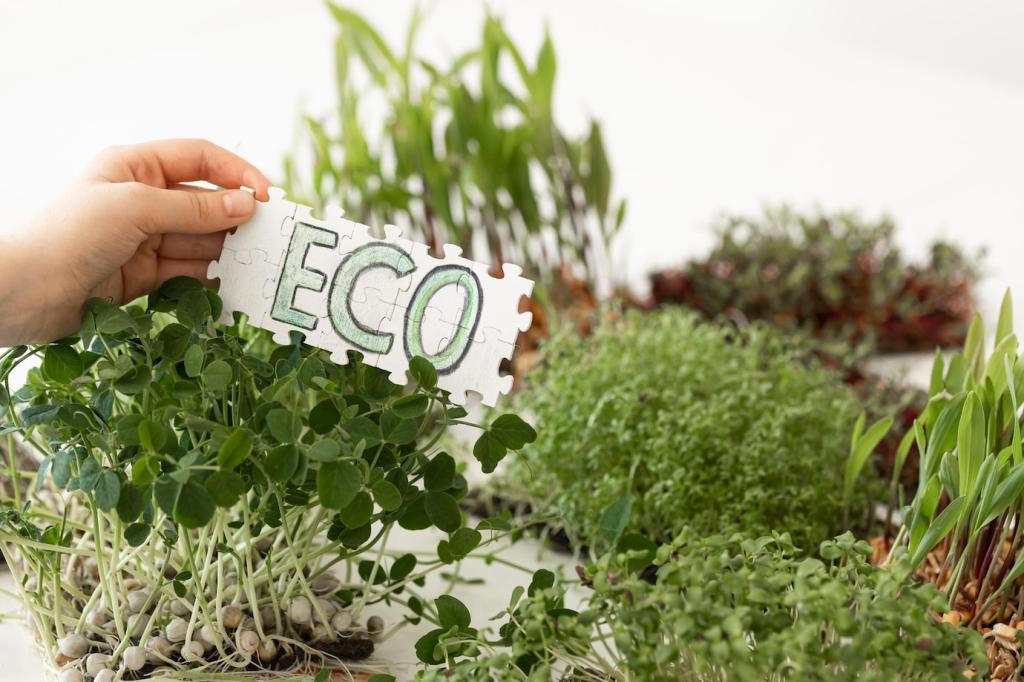Care That Comes Full Circle: Recyclable and Biodegradable Materials for Sustainable Furniture Care
Selected theme: Recyclable and Biodegradable Materials for Sustainable Furniture Care. Welcome to a home care philosophy where every bottle, brush, and polish respects the planet—and helps your furniture age beautifully, not wastefully.

Understanding Recyclable vs. Biodegradable in Furniture Care
Recyclable at a Glance
Recyclable materials can be collected, processed, and turned into new items, reducing demand for virgin resources. In furniture care, think PET or HDPE spray bottles, aluminum caps, and steel tins for waxes. Clean, label-free containers sorted properly make your local facility far more likely to accept and actually reprocess them.
Biodegradable in Practice
Biodegradable items break down by natural processes into simpler substances, ideally without leaving toxic residues. Plant-based surfactants, cellulose cloths, and natural bristle brushes can decompose, especially in managed compost. Check whether products are home-compostable or require industrial conditions, and keep them uncontaminated by synthetic residues.
Avoiding Greenwashing
Look for credible certifications and clarity. For compostables, seek BPI or TÜV marks; for wood tools, FSC signals responsible sourcing. Claims like “eco-friendly” without data are red flags. Transparent ingredient lists, disposal instructions, and lifecycle details show a brand is serious about verifiable sustainability rather than feel-good marketing.
Biodegradable Cleaning Recipes for Every Surface
Infuse white vinegar with citrus peels, then dilute one part infusion with two parts water and a teaspoon of olive or walnut oil. Mist lightly and buff with a cellulose cloth, testing first on an inconspicuous spot. My grandmother’s oak sideboard glowed after one pass—share your own before-and-after stories and subscribe for weekly recipes.
Biodegradable Cleaning Recipes for Every Surface
Combine baking soda with a few drops of castile soap and water to create a soft paste. Apply with a natural-bristle brush, then rinse and dry thoroughly to prevent oxidation. Skip harsh ammonia or petroleum solvents. This paste revived our thrifted brass handles without fumes, and it rinsed cleanly, leaving only a light, natural sheen.


Tools and Containers That Close the Loop
Select brushes with bamboo handles and sisal or tampico bristles. They scrub effectively and avoid microplastic shedding. After months of service, remove any metal staples for recycling and compost the plant-based parts. Keep them dry between uses to prevent mildew. Share how long yours last and tag us in a photo of your toolkit.


Tools and Containers That Close the Loop
Opt for amber glass bottles with stainless-steel or high-quality, recyclable pump components. They reduce plastic waste and keep formulations stable. Use silicone sleeves for grip and longevity rather than replacing bottles. Set a refill calendar, and encourage neighbors to join a small refill club. Subscribe for our printable bottle label templates.
Repairs and Finishes with Nature-Friendly Ingredients
Linseed, tung, and candelilla wax blends nourish wood, creating protective finishes that can be renewed without stripping harsh varnishes. Apply thin coats, buff patiently, and ventilate well. Store oil-soaked rags safely in sealed metal containers to prevent spontaneous combustion. Tell us your finish of choice and subscribe for our seasonal maintenance checklist.
Waste Less: Smart End-of-Life and Composting

Retire cellulose cloths, cotton rags, and loofah pads by cutting them into smaller pieces for faster breakdown. Keep them free of synthetic finishes before composting. In our backyard bin, cotton threads vanished in a season. Post your compost timelines and join our newsletter for a quick guide to home versus industrial composting.
Stories from Homes Embracing Sustainable Furniture Care
After swapping to homemade polish, refillable bottles, and bamboo brushes, the Lopez family cut their cleaning waste by two-thirds and spent less overall. Their oak dining table looks richer, and the kids help mix refills. Share your household results, and subscribe to receive a simple tracker for measuring waste and savings each month.
In a studio apartment, Maya keeps a tidy worm bin under her sink. Cellulose cloth strips and tea leaves become nutrient-rich castings for her balcony herbs. She says the bin smells like forest soil, not trash. Curious about vermicomposting? Ask questions below, and we will publish a beginner’s guide next week.
Once a month, our block hosts a refill table and light repair corner for loose chair legs and squeaky hinges. Swapped hardware, exchanged recipes, and lots of laughter. Want a starter kit for organizing your own? Comment “REFILL” and follow—our downloadable checklist and signage pack arrives in Friday’s newsletter.
